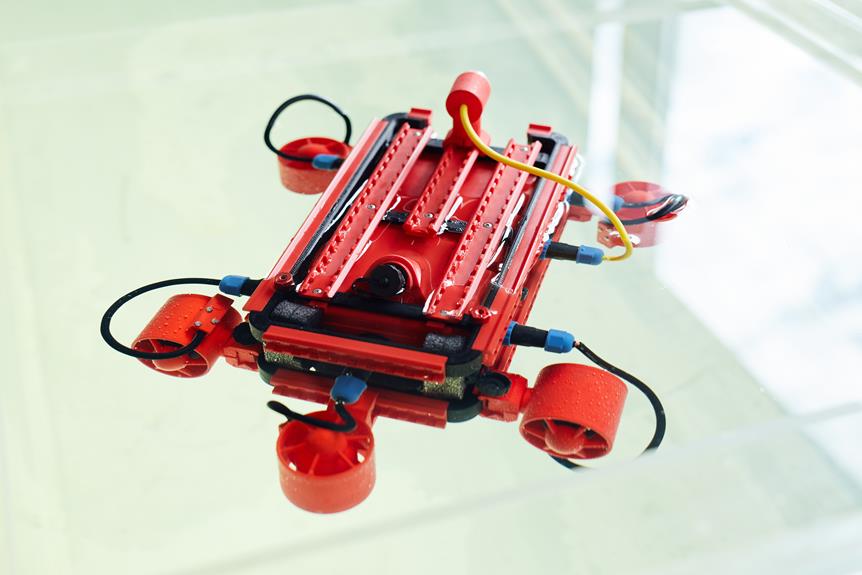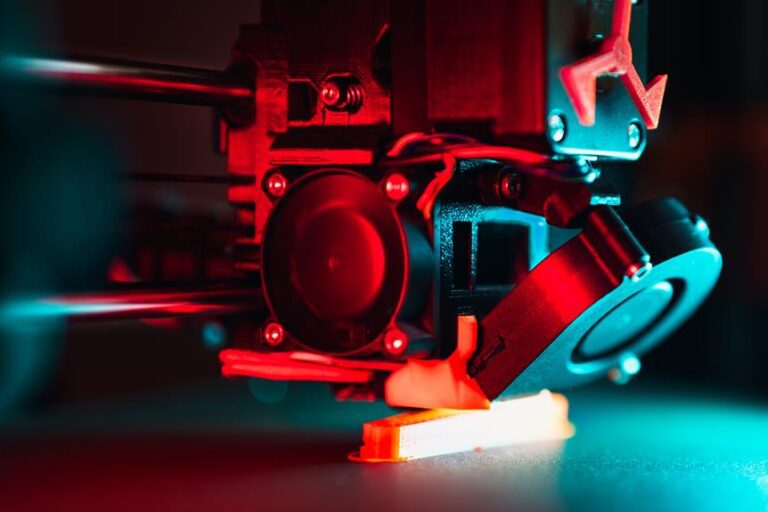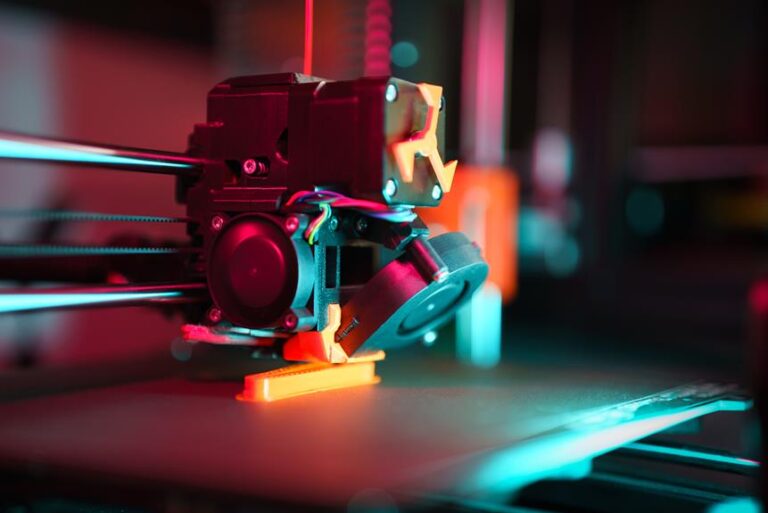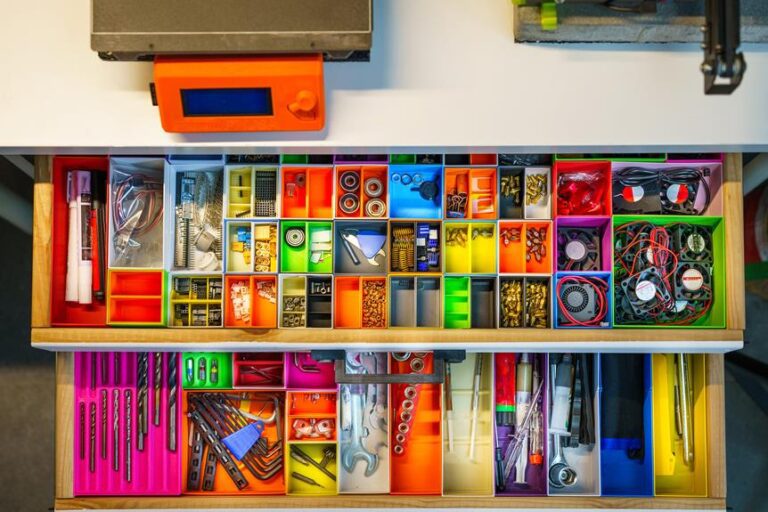3D Printing in the Aerospace Industry: Redefining Flight
In the vast expanse of the aerospace industry, a new technology has emerged, spreading its wings and soaring to new heights. Like a phoenix rising from the ashes, 3D printing has revolutionized flight, reshaping the way we design, manufacture, and produce aircraft.
With its ability to create lightweight components, intricate geometries, and reduce lead times, 3D printing has become the liberating force that is redefining flight in the aerospace industry.
Join us as we embark on a journey through the transformative power of 3D printing in aerospace.
Key Takeaways
- Significant reduction in manufacturing costs
- Lightweight components and enhanced fuel efficiency
- Revolutionizing flight design with complex geometries
- Reduced lead times and streamlined supply chain in aerospace production
Advantages of 3D Printing in Aerospace
One of the key advantages of 3D printing in the aerospace industry is its ability to significantly reduce manufacturing costs. Aerospace additive manufacturing, also known as aircraft 3D printing, has revolutionized the way aircraft parts and components are produced.
Traditional manufacturing methods often involve complex and costly processes, such as machining and casting, which require expensive tooling and labor. However, with the advent of 3D printing technology, aerospace manufacturers can now produce parts directly from digital designs, eliminating the need for costly tooling and reducing the overall production time.
By leveraging the benefits of additive manufacturing, aerospace companies can achieve substantial cost savings. With 3D printing, complex parts can be produced in a single step, reducing the need for assembly and reducing material waste. Additionally, the ability to print parts on-demand eliminates the need for inventory storage, further reducing costs.
Furthermore, 3D printing allows for the production of lightweight and optimized parts, which can result in fuel savings for aircraft.
Lightweight Components in Aircraft Manufacturing
Leveraging advanced additive manufacturing techniques, the aerospace industry is able to produce lightweight components that enhance aircraft performance and fuel efficiency. This breakthrough in aircraft manufacturing has revolutionized the way aircraft are designed and built, offering numerous benefits to both manufacturers and operators.
Here are three key advantages of using 3D printing technology to create lightweight components in the aerospace industry:
- Weight Reduction: Traditional manufacturing methods often involve the use of multiple parts and joining techniques, which can add unnecessary weight to the aircraft. With 3D printing, complex geometries can be created in a single piece, eliminating the need for assembly and reducing overall weight. This weight reduction translates to improved fuel efficiency, increased payload capacity, and enhanced maneuverability.
- Material Optimization: 3D printing allows for the use of advanced materials that are not easily machinable or castable. By using lightweight materials such as titanium alloys or carbon fiber composites, aerospace manufacturers can achieve a higher strength-to-weight ratio, resulting in stronger and more durable components. This enables the production of aircraft that are both lighter and more resistant to fatigue, ultimately increasing their lifespan.
- Design Flexibility: Additive manufacturing offers unparalleled design freedom, allowing engineers to create complex and intricate structures that were previously impossible to manufacture using traditional methods. By optimizing the internal structure and reducing material waste, 3D printed lightweight components can be tailored to specific aircraft requirements, leading to improved aerodynamics and better overall performance.
The adoption of 3D printing in aerospace has opened up new possibilities for the industry, enabling the production of lightweight components that enhance aircraft performance and fuel efficiency. As this technology continues to evolve, we can expect to see even more innovative applications in the field of aircraft manufacturing.
Complex Geometries Revolutionizing Flight Design
Furthermore, by harnessing the power of advanced additive manufacturing techniques, the aerospace industry is now able to incorporate complex geometries into flight design, revolutionizing the way aircraft are built and operated. The ability to create intricate and customized shapes through 3D printing has opened up new possibilities for flight design, allowing for improved aerodynamics, reduced weight, and increased fuel efficiency.
One of the key advantages of using complex geometries in flight design is the ability to optimize airflow around the aircraft. Traditional manufacturing methods often limit the shapes that can be produced, resulting in compromises in aerodynamic performance. With 3D printing, designers can now create intricate structures, such as winglets and airfoils, that reduce drag and improve overall efficiency.
Another benefit of incorporating complex geometries is the ability to reduce weight while maintaining structural integrity. By using lattice structures and internal truss-like designs, components can be lighter without sacrificing strength. This not only improves fuel efficiency but also allows for increased payload capacity.
The table below showcases some examples of complex geometries that are being utilized in flight design:
| Component | Complex Geometry |
|---|---|
| Winglets | Twisted or curved profiles |
| Airfoils | Serrated or scalloped edges |
| Engine Components | Complex internal channels |
| Fuselage | Lattice structures |
Reducing Lead Times in Aerospace Production
Reducing lead times in aerospace production is a critical objective for the industry. Faster aerospace manufacturing is now possible with the advent of additive manufacturing technologies.
Faster Aerospace Manufacturing
In the realm of aerospace manufacturing, the quest for faster production and reduced lead times has become a paramount goal for industry leaders. The adoption of 3D printing technology has revolutionized the manufacturing process, offering several advantages that contribute to faster aerospace production.
Here are three key ways 3D printing is helping to achieve faster manufacturing in the aerospace industry:
- Rapid prototyping: 3D printing allows for the quick and cost-effective production of prototypes, enabling engineers to test and refine designs at a faster pace.
- On-demand production: With 3D printing, aerospace components can be produced on-demand, eliminating the need for lengthy lead times associated with traditional manufacturing methods.
- Streamlined supply chain: By utilizing 3D printing, aerospace manufacturers can reduce their reliance on complex supply chains, resulting in faster production and delivery times.
These advancements in 3D printing technology are enabling the aerospace industry to accelerate its manufacturing processes and reduce lead times, ultimately contributing to the overall efficiency and competitiveness of the industry.
Time-Saving Additive Manufacturing
By utilizing additive manufacturing techniques, the aerospace industry has found an effective solution to significantly reduce lead times in production. This time-saving approach has revolutionized the way aircraft components are manufactured, allowing for quicker turnaround times and increased efficiency. Additive manufacturing, also known as 3D printing, enables the creation of complex geometries and intricate designs that were previously difficult to produce using traditional manufacturing methods. The table below illustrates the time-saving benefits of additive manufacturing in the aerospace industry.
| Traditional Manufacturing | Additive Manufacturing |
|---|---|
| Lengthy production processes | Rapid production cycles |
| High tooling and setup costs | Lower tooling and setup costs |
| Limited design freedom | Extensive design flexibility |
| Longer lead times | Shorter lead times |
With the ability to produce parts in a fraction of the time, additive manufacturing has become a game-changer in the aerospace industry, allowing for faster product development and ultimately redefining the future of flight.
Innovations in Aircraft Manufacturing With 3D Printing
The implementation of 3D printing in aircraft manufacturing has brought about numerous innovations that have revolutionized the industry. One of the key advantages is the ability to create lightweight components, reducing the overall weight of the aircraft and improving fuel efficiency.
Additionally, 3D printing enables the production of durable components that meet stringent safety standards.
Moreover, the technology has significantly accelerated the production processes, allowing for faster turnaround times and increased productivity.
Lastly, the cost-effective nature of 3D printing has made it a viable solution for manufacturers, offering a more efficient and economical approach to aircraft manufacturing.
Lightweight, Durable Components
With the advent of 3D printing technology, aircraft manufacturers have been able to produce lightweight, durable components that enhance overall performance and fuel efficiency. This innovation has paved the way for significant advancements in aircraft manufacturing.
Here are three key benefits of using 3D printing to create lightweight, durable components in the aerospace industry:
- Reduced Weight: 3D printing allows for the creation of intricate designs and complex geometries, resulting in lighter components. This reduction in weight contributes to increased fuel efficiency and lower operating costs.
- Enhanced Durability: By using advanced materials such as carbon fiber-reinforced polymers and titanium alloys, 3D printed components exhibit superior strength and durability compared to traditional manufacturing methods.
- Optimized Performance: The ability to customize and fine-tune components using 3D printing enables manufacturers to optimize the performance of aircraft. This includes improved aerodynamics, reduced drag, and increased overall efficiency.
Faster Production Processes
Advancing aircraft manufacturing processes, 3D printing technology enables faster production and enhances efficiency in the aerospace industry.
With its ability to rapidly produce complex and intricate components, 3D printing has revolutionized the way aircraft are manufactured. Traditional manufacturing methods often involve multiple steps, such as machining and assembly, which can be time-consuming and costly.
However, 3D printing allows for the direct production of parts, eliminating the need for multiple stages and reducing production time significantly. Moreover, the design flexibility offered by 3D printing enables engineers to optimize the shape and structure of components, further enhancing efficiency and reducing weight.
By streamlining the production process and utilizing lightweight materials, aircraft manufacturers can achieve faster production rates without compromising on quality or safety.
This technological innovation has the potential to transform the aerospace industry and redefine the future of flight.
Cost-Effective Manufacturing Solutions
One of the key advantages of 3D printing in the aerospace industry is its ability to offer cost-effective manufacturing solutions. This technology has revolutionized the way aircraft parts are produced, providing significant cost savings for manufacturers.
Here are three ways in which 3D printing has enabled cost-effective manufacturing in the aerospace industry:
- Reduced material waste: Traditional manufacturing methods often produce a significant amount of waste material. With 3D printing, parts can be built layer by layer, minimizing material waste and reducing costs.
- Streamlined supply chains: 3D printing allows for on-demand production, eliminating the need for large inventories and reducing supply chain costs. Manufacturers can produce parts as needed, saving on storage and transportation expenses.
- Design optimization: 3D printing enables complex geometries and intricate designs that were previously impossible to manufacture. This allows for lightweighting and optimization, reducing material usage and ultimately lowering costs.
How 3D Printing Is Redefining Flight in the Aerospace Industry
What role does 3D printing play in redefining the flight capabilities of the aerospace industry?
3D printing, also known as additive manufacturing, has emerged as a game-changing technology in the aerospace industry. It has revolutionized the way aircraft components are designed, manufactured, and assembled, leading to significant advancements in flight capabilities.
One of the key ways 3D printing is redefining flight is through the production of lightweight and complex parts. Traditional manufacturing methods often limit the design possibilities due to constraints in tooling and machining. However, with 3D printing, complex geometries can be easily achieved, allowing for the creation of intricate and optimized components. These lighter parts contribute to weight reduction, enhancing aircraft performance, fuel efficiency, and ultimately, flight capabilities.
Moreover, 3D printing enables the production of on-demand and customized parts, reducing lead times and costs. This technology eliminates the need for extensive tooling and inventory storage, enabling aerospace companies to produce parts as needed. With the ability to quickly manufacture replacement parts, maintenance and repair processes become more efficient, minimizing aircraft downtime and improving flight readiness.
Additionally, 3D printing allows for the integration of multiple functions within a single component. Through the use of additive manufacturing techniques, various functionalities such as electrical conductivity, thermal management, and structural integrity can be incorporated into a single part. This consolidation of functions not only streamlines the manufacturing process but also enhances the overall performance and reliability of the aircraft.
Frequently Asked Questions
What Are the Safety Considerations and Regulations Involved in Using 3D Printed Parts in Aircraft Manufacturing?
Safety considerations and regulations involved in using 3D printed parts in aircraft manufacturing include material integrity, certification process, quality control, and adherence to industry standards. Compliance with these measures ensures the reliability and airworthiness of the printed components.
How Does 3D Printing Technology Impact the Cost of Production in the Aerospace Industry?
3D printing technology has revolutionized the aerospace industry's production costs by reducing manufacturing time and material waste. This innovative approach has led to significant cost savings, making aircraft manufacturing more efficient and economically viable.
Can 3D Printing Be Used to Produce Large-Scale Aircraft Components, Such as Wings or Fuselages?
Yes, 3D printing can be utilized to produce large-scale aircraft components, such as wings or fuselages. This technology offers numerous advantages, including the ability to create complex designs, reduce weight, improve fuel efficiency, and streamline the production process.
Are There Any Limitations or Challenges Associated With Integrating 3D Printed Parts Into Existing Aircraft Designs?
Integrating 3D printed parts into existing aircraft designs poses challenges. Like a puzzle, these parts must fit seamlessly and meet strict safety and performance standards. Thorough testing and certification processes are required to ensure successful integration.
What Are the Potential Environmental Benefits of Using 3D Printing in Aerospace Manufacturing?
The potential environmental benefits of using 3D printing in aerospace manufacturing include reduced waste from material usage, energy efficiency in production, and the ability to create complex designs that optimize fuel efficiency and reduce emissions.
Conclusion
In conclusion, the use of 3D printing in the aerospace industry has revolutionized flight design and manufacturing processes.
With the ability to create lightweight components and complex geometries, aircrafts are now more efficient and advanced than ever before.
Additionally, the reduced lead times in production have allowed for faster innovation and development in the industry.
This technology has truly redefined flight, pushing the boundaries of what is possible in the aerospace field.
So buckle up and get ready to soar to new heights with 3D printing.









